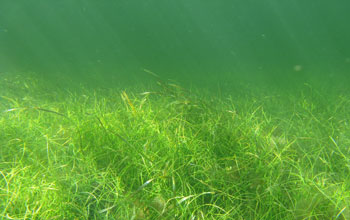Seagrasses Can Store as Much Carbon as Forests
Posted on 18 June 2012 by John Hartz
This is a reprint of a news release posted by the National Science Foundation (NSF) on May 21, 2012.
![]()
Researchers find that the global carbon pool in seagrass beds is as much as 19.9 billion metric tons

Dense seagrass meadows are a hallmark of the Florida Coastal Everglades LTER site.
Credit: Florida Coastal Everglades LTER Site
Seagrasses are a vital part of the solution to climate change and, per unit area, seagrass meadows can store up to twice as much carbon as the world's temperate and tropical forests.
So report researchers publishing a paper this week in the journal Nature Geoscience.
The paper, "Seagrass Ecosystems as a Globally Significant Carbon Stock," is the first global analysis of carbon stored in seagrasses.
The results demonstrate that coastal seagrass beds store up to 83,000 metric tons of carbon per square kilometer, mostly in the soils beneath them.
As a comparison, a typical terrestrial forest stores about 30,000 metric tons per square kilometer, most of which is in the form of wood.
The research also estimates that, although seagrass meadows occupy less than 0.2 percent of the world's oceans, they are responsible for more than 10 percent of all carbon buried annually in the sea.
"Seagrasses only take up a small percentage of global coastal area, but this assessment shows that they're a dynamic ecosystem for carbon transformation," said James Fourqurean, the lead author of the paper and a scientist at Florida International University and the National Science Foundation's (NSF) Florida Coastal Everglades Long-Term Ecological Research (LTER) site.
The Florida Coastal Everglades LTER site is one of 26 such NSF LTER sites around the world in ecosystems from forests to tundra, coral reefs to barrier islands.
"Seagrasses have the unique ability to continue to store carbon in their roots and soil in coastal seas," said Fourqurean. "We found places where seagrass beds have been storing carbon for thousands of years."
The research was led by Fourqurean in partnership with scientists at the Spanish High Council for Scientific Investigation, the Oceans Institute at the University of Western Australia, Bangor University in the United Kingdom, the University of Southern Denmark, the Hellenic Center for Marine Research in Greece, Aarhus University in Denmark and the University of Virginia.
Seagrass meadows, the researchers found, store ninety percent of their carbon in the soil--and continue to build on it for centuries.
In the Mediterranean, the geographic region with the greatest concentration of carbon found in the study, seagrass meadows store carbon in deposits many meters deep.
Seagrasses are among the world's most threatened ecosystems. Some 29 percent of all historic seagrass meadows have been destroyed, mainly due to dredging and degradation of water quality. At least 1.5 percent of Earth's seagrass meadows are lost every year.
The study estimates that emissions from destruction of seagrass meadows can potentially emit up to 25 percent as much carbon as those from terrestrial deforestation.
"One remarkable thing about seagrass meadows is that, if restored, they can effectively and rapidly sequester carbon and reestablish lost carbon sinks," said paper co-author Karen McGlathery, a scientist at the University of Virginia and NSF's Virginia Coast Reserve LTER site.
The Virginia Coast Reserve and Florida Coastal Everglades LTER sites are known for their extensive seagrass beds.
Seagrasses have long been recognized for their many ecosystem benefits: they filter sediment from the oceans; protect coastlines against floods and storms; and serve as habitats for fish and other marine life.
The new results, say the scientists, emphasize that conserving and restoring seagrass meadows may reduce greenhouse gas emissions and increase carbon stores--while delivering important "ecosystem services" to coastal communities.
The research is part of the Blue Carbon Initiative, a collaborative effort of Conservation International, the International Union for Conservation of Nature, and the Intergovernmental Oceanographic Commission of UNESCO.
Journal Reference:
James W. Fourqurean, Carlos M. Duarte, Hilary Kennedy, Núria Marbà, Marianne Holmer, Miguel Angel Mateo, Eugenia T. Apostolaki, Gary A. Kendrick, Dorte Krause-Jensen, Karen J. McGlathery, Oscar Serrano. Seagrass ecosystems as a globally significant carbon stock. Nature Geoscience, 2012; DOI: 10.1038/ngeo1477































 Arguments
Arguments























 0
0  0
0






Comments